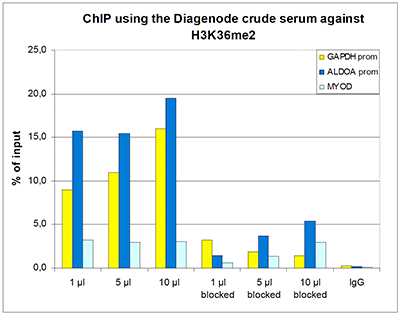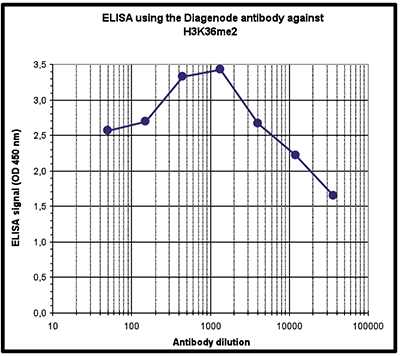 Figure 1. ChIP results obtained with the Diagenode antibody directed against H3K36me2
Figure 1. ChIP results obtained with the Diagenode antibody directed against H3K36me2ChIP assays were performed using human HeLa cells, the Diagenode antibody against H3K36me2 (Cat. No. C15310127) and optimized PCR primer sets for qPCR. ChIP was performed with the “LowCell# ChIP” kit (Cat. No. C01010070), using sheared chromatin from 10,000 cells. A titration of the antibody consisting of 1, 5, and 10 μl per ChIP experiment was analysed. Additionally, the same titration was analysed after incubation of the antibody with 5 nmol blocking peptide (Cat. No. C16000127 ) for 1 hour at room temperature. IgG (5 μg/IP) was used as negative IP control. QPCR was performed with primers for the promoter of the active genes GAPDH and ALDOA and for the coding region of the myogenic differentiation gene (MYOD). Figure 1 shows the recovery, expressed as a % of input (the relative amount of immunoprecipitated DNA compared to input DNA after qPCR analysis).
 Figure 2. ChIP-seq results obtained with the Diagenode antibody directed against H3K36me2
Figure 2. ChIP-seq results obtained with the Diagenode antibody directed against H3K36me2ChIP was performed with 0.5 μl of the Diagenode antibody against H3K36me2 (Cat. No. C15310127) on sheared chromatin from 1 million HeLa cells using the “iDeal ChIP-seq” kit (Cat. No. C01010051). The IP’d DNA was subsequently analysed on an Illumina Genome Analyzer. Library preparation, cluster generation and sequencing were performed according to the manufacturer’s instructions. The 36 bp tags were aligned to the human genome using the ELAND algorithm. Figure 2 shows the signal distribution along 3 genomic regions of chromosome 20, 12 and X, respectively.
 Figure 3. Determination of the titer
Figure 3. Determination of the titerTo determine the titer, an ELISA was performed using a serial dilution of the Diagenode antibody directed against H3K36me2 (Cat. No. C15310127). The antigen used was a peptide containing the histone modification of interest. By plotting the absorbance against the antibody dilution (Figure 3), the titer of the antibody was estimated to be 1:31,000.
 Figure 4. Cross reactivity test using the Diagenode antibody directed against H3K36me2
Figure 4. Cross reactivity test using the Diagenode antibody directed against H3K36me2A dot blot analysis was performed to test the cross reactivity of the Diagenode antibody against H3K36me2 (Cat. No. C15310127) with peptides containing other modifications and unmodified sequences of histone H3. One hundred to 0.2 pmol of the peptide containing the respective histone modification were spotted on a membrane. The antibody was used at a dilution of 1:100,000. Figure 4 shows a high specificity of the antibody for the modification of interest.
 Figure 5. Western blot analysis using the Diagenode antibody directed against H3K36me2
Figure 5. Western blot analysis using the Diagenode antibody directed against H3K36me2Histone extracts of HeLa cells (15 μg) were analysed by Western blot using the Diagenode antibody against H3K36me2 (Cat. No. C15310127) diluted 1:1,000 in TBS-Tween containing 5% skimmed milk. The position of the protein of interest is indicated on the right; the marker (in kDa) is shown on the left. The result of the Western analysis with the antibody is shown in lane 1; lane 2 shows the same analysis after incubation of the antibody with 5 nmol blocking peptide (Cat. No. C16000127 ) for 1 hour at room temperature.
 Figure 6. Immunofluorescence using the Diagenode antibody directed against H3K36me2
Figure 6. Immunofluorescence using the Diagenode antibody directed against H3K36me2 HeLa cells were stained with the Diagenode antibody against H3K36me2 (Cat. No. C15310127) and with DAPI. Cells were fixed with 4% formaldehyde for 10’ and blocked with PBS/TX-100 containing 5% normal goat serum and 1% BSA. The cells were immunofluorescently labelled with the H3K36me2 antibody (left) diluted 1:500 in blocking solution followed by an anti-rabbit antibody conjugated to Alexa488. The middle panel shows staining of the nuclei with DAPI. A merge of the two stainings is shown on the right.






